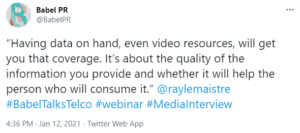
Top PR media pitching tips
Pitching story ideas, product announcements and press releases to trade and national journalists is one of the most fundamental aspects of a job in PR.
However, with fewer journalists, changing news cycles and vast amounts of media outlets, PRs need to be top of their game when selling in a story.
Following Babel’s recent webinar with Ray Le Maistre, the editorial director at TelecomTV, I started thinking more about what makes an effective pitch, and about how I prefer to speak to journalists. So here are some top tips on how to best engage with key media!
Pitching during a pandemic
When I first started in PR, I absolutely dreaded the thought of picking up the phone and speaking to a journalist, but now, I love it. Having worked remotely for so long, getting in that ‘people time’ really does brighten my day. However, as journalists are working away from their offices and often aren’t too keen on being pitched to on their personal numbers, it’s worth considering alternative channels.
During Babel’s webinar, Le Maistre highlighted LinkedIn and Twitter as “efficient ways of pitching,” and his preferred means of communication with PRs.
Content is key
Le Maistre also highlighted that whilst he isn’t bored of hearing about a certain topic, he is tired of being pitched “500 words of nothing”:
“Are there any topics you’re slightly fatigued of hearing about now?” asks @PaulSCam
It may be the first rule you learn as a PR professional, but when you pick up the phone, however experienced you are and however well you know your topic, you should always have a concise elevator pitch to hand. If you can relay your press release, news story or thought-leadership angle in 50 words, rather than 500, I am sure a journalist will thank you for it.
Data matters
Le Maistre also suggested that if you include the following three aspects in your pitch, you are almost guaranteed to get coverage: people, technology, and money. Further, having relevant data on hand will help you too.
Journalists want a story, so making sure you pitch this rather than a product will help them envision how they can grab their reader’s attention.
Cultivate genuine relationships
You must also make sure your approach to pitching is centered around the fact that PR is a two-way street – cultivating genuine relationships, without expecting something from every journalist you speak to, is so important in this industry.
Follow journalists on Twitter, making sure to keep up to date with what they’re writing about and genuinely interested in, rather than pitching a security story to a science correspondent.
As soon as we’re able, book some drinks into the diaries too!
Stay tuned for part two of this blog, where I will be asking more journalists for their top pitching tips.
If you would like to hear more about how we effectively engage with media for our clients, please do get in touch.







